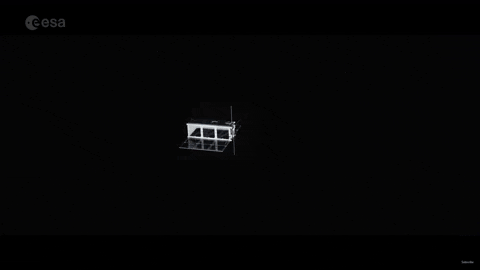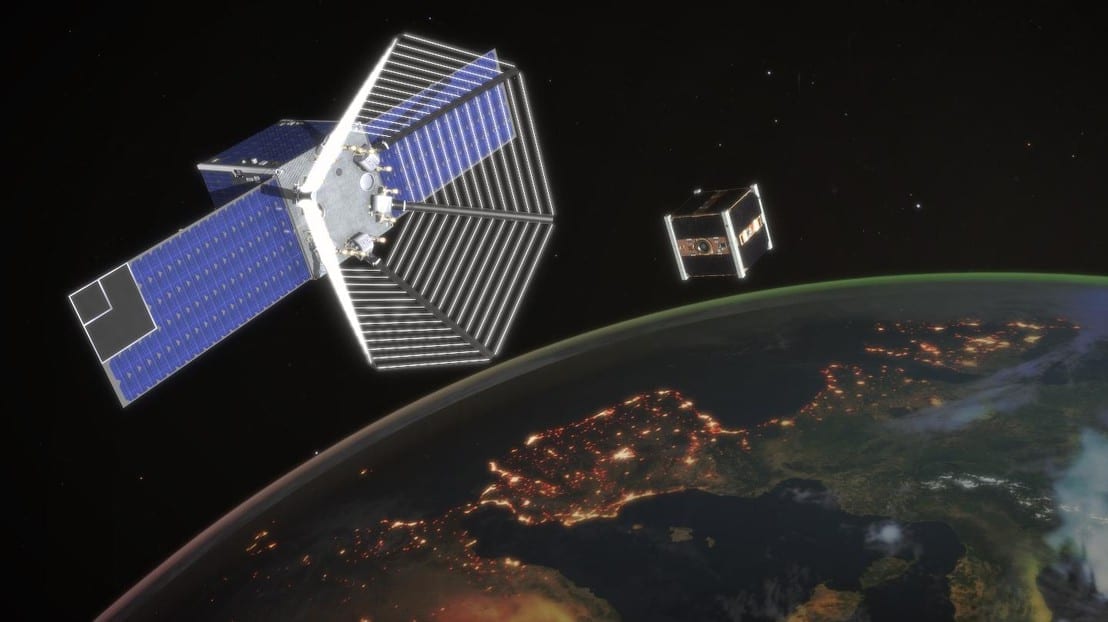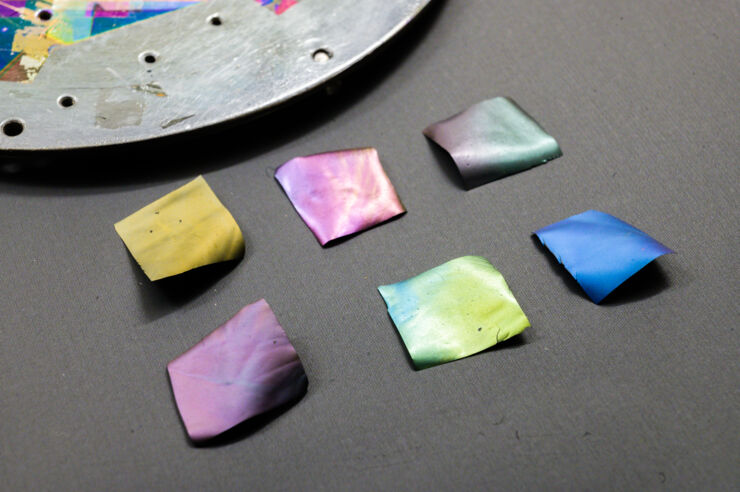
Animated depiction of a spacecraft deploying a drag sail in orbit
The Drag Augmentation Deorbiting System (ADEO) breaking sail was successfully deployed from the ION satellite carrier in late December 2022. A sail area of 3.6 square meters was autonomous deployed from an impressively small packing size of 10 x 10 x 10 cm to demonstrate deorbiting satellite technology.
We want to establish a zero debris policy, which means if you bring a spacecraft into orbit you have to remove it. Josef Aschbacher, ESA Director General
ADEO’s deployment was captured in front of the ‘eyes’ of the integrated camera onboard the ION satellite carrier, as ADEO unfurled showing its “wings’, and immediately initiated the satellite’s descent – known as deorbiting. The image shows one edge of the sail – a large aluminium-coated polyamide membrane attached to four carbon-fibre reinforced booms, following its jack-in-a-box deployment.
The sail provides a passive method of deorbiting by increasing the atmospheric surface drag effect and causing an accelerated decay in the satellite’s orbital altitude. The satellite will eventually burn-up in the atmosphere, providing a quicker residue-free method of disposal. ADEO gently pushes the ION satellite carrier, as if it’s on “angel wings”, out of its orbit and towards Earth’s atmosphere.
Adeptly named “Show Me Your Wings” the ADEO-mission is the final in-flight qualification test needed to provide the technological proof-of-concept. A smaller 2.5 square meter sail was fitted onto the upper stage of the Electron launch vehicle “Its Business Time” mission in 2018 and several parabolic flights were performed from 2019 to 2022.
The ADEO test model is the smallest variation of the ADEO product family, designed especially for the de-orbit of small satellites in the 1-100 kg class range. The approach is however scalable for medium and large size satellites. Multiple units, on one satellite or an upper stage is also option, if the accommodation of a larger sail is unfeasible. Tailor-made solutions depend on the initial orbit, satellite mass and required de-orbiting time. The largest variation can be as big as 100 square meters and take up to 45 mins to deploy. The smallest sail is just 3.5 square meters and deploy in just 0.8 seconds!
ADEO technology provides a safe, robust and sustainable method of passively de-orbiting small satellites. Passive methods of deorbiting are advantageous in eliminating the need for active steering, with no additional GNC or propulsion subsystem. The system can be designed for passive attitude stabilisation and the approach is applicable for non-operational and tumbling satellites
Reliably removing satellites as they approach their system end-of-life, or satellites that have become unresponsive, is a key aspect in ESA’s ESA’s Zero Debris Initiative. Valuable orbits become available for use and the probability of unwanted collision decreases – which would only create the next generation of space debris.
Original Article: Show Me Your Wings: Successful In-flight Demonstration of the ADEO Braking Sail
More from: European Space Agency
The Latest Updates from Bing News
Go deeper with Bing News on:
Deorbiting satellite technology
- Beavers are helping fight climate change, satellite data shows
Scientists at Utah's Boise State University and Utah State University are using satellite data to identify streams where once-eradicated beavers can be re-introduced to boost vegetation. They're also ...
- Marvell Technology
Marvell Technology Group Ltd. engages in the design, development, and sale of integrated circuits. The company offers System-on-a-Chip devices, which leverages technology portfolio of intellectual ...
- BAE Systems-built CloudSat satellite completes nearly two decades-long mission
The NASA mission provided data on cloud profiles and physical properties to enhance weather prediction models "The deorbiting of ... "The fact that the satellite was able to provide meaningful ...
- India aims to achieve 'debris-free' space missions by 2030
"We want to make sure that for all the spacecraft we are likely to launch in the future, we will be taking action to make sure that we de-orbit and bring it to a safe location." ...
- Researchers develop performance technology for aerial and satellite image extraction
The development of the world's most performant neural network module for accurately extracting objects from aerial and satellite imagery is expected to have wide applications across various fields, ...
Go deeper with Bing News on:
Deorbiting satellites
- Debris dilemma: Japan’s mission makes progress in orbital clean-up efforts
The ADRAS-J spacecraft, acting like a garbage truck in orbit, just finished getting close to a rocket that's been floating around since 2009.
- NASA Concludes CloudSat Mission
NASA’s CloudSat mission was decommissioned in March and moved into position for eventual deorbiting, marking the end of nearly 18 years of operation. CloudSat was launched in 2006 and was originally ...
- Mysterious fireball trailing lights up sky over China ‘travelling 1,000 miles’ before breaking up & vanishing
The blazing fireball that lit up the sky with an orange glow above the Chinese capital Beijing was also seen more than 1,000 miles away in Gansu province before it broke into smaller pieces ...
- NASA’s CloudSat Satellite Concludes 17-Year Mission Enhancing Weather Predictions
After over 17 years in orbit, NASA's CloudSat satellite, constructed by BAE Systems, has concluded its mission, providing crucial data on cloud p ...
- BAE Systems-built CloudSat satellite completes nearly two decades-long mission
CloudSat was originally planned for a 22-month mission lifetime, but it was able to continue providing measurements for nearly 18 years in large part due to operational support efforts from the BAE ...










